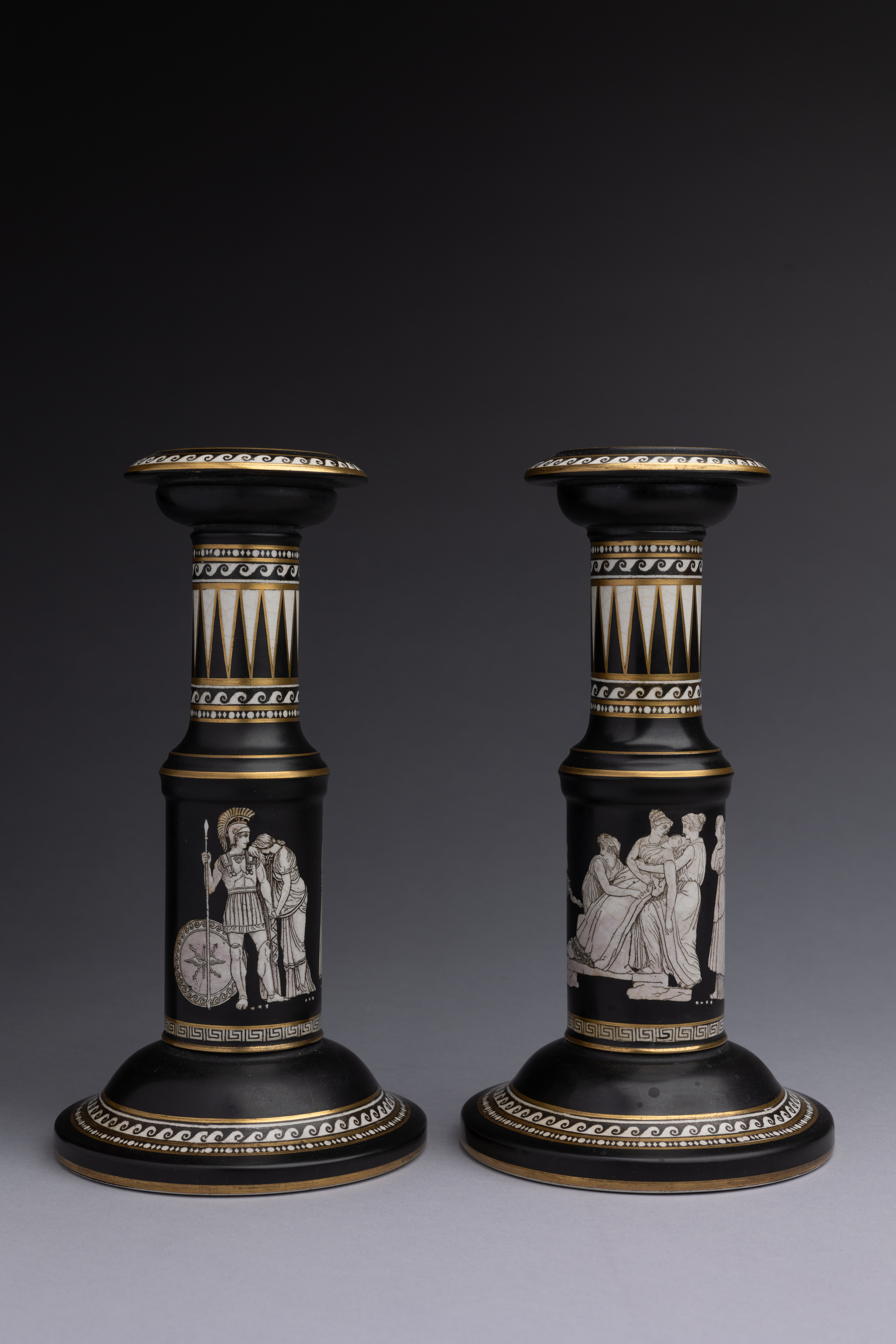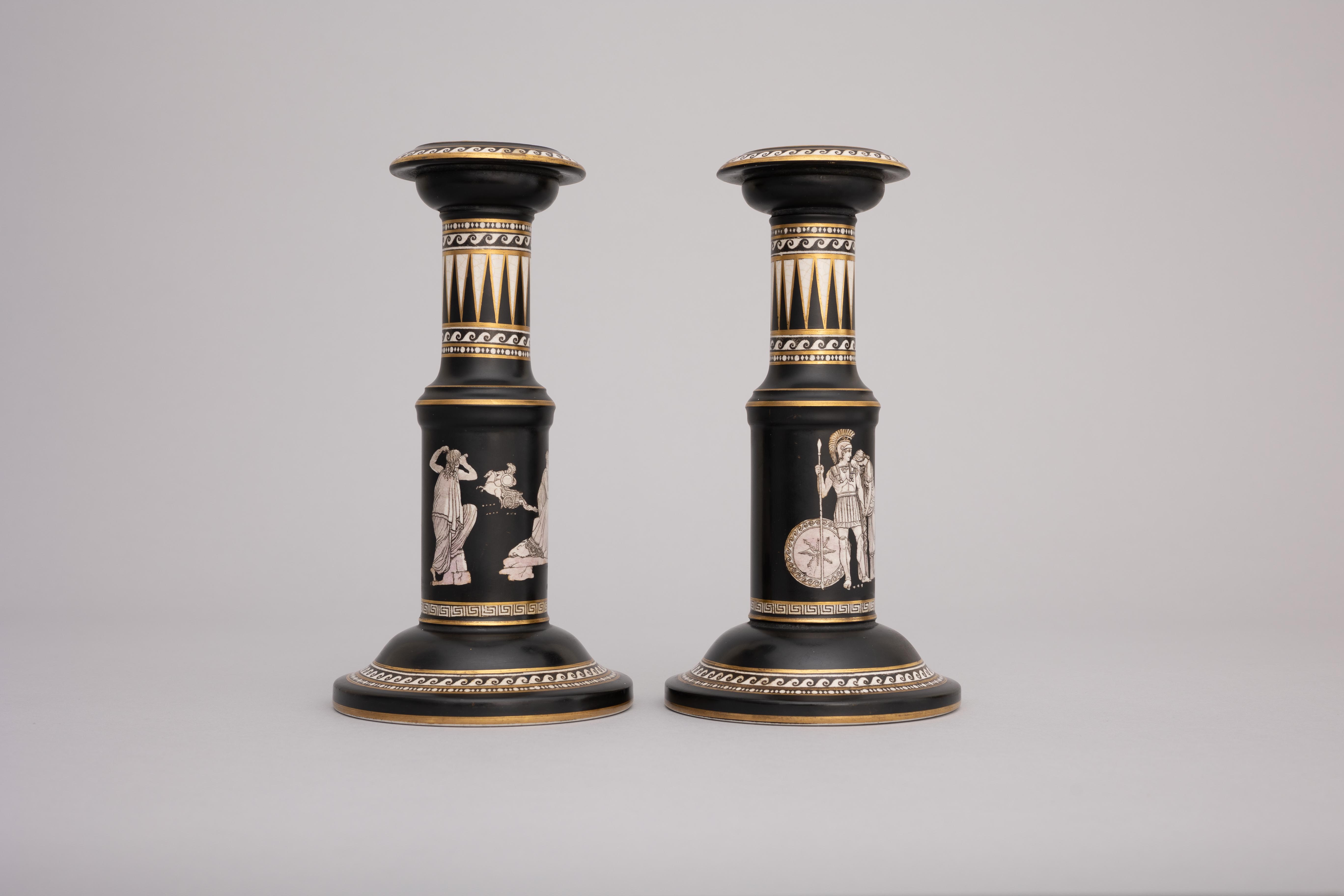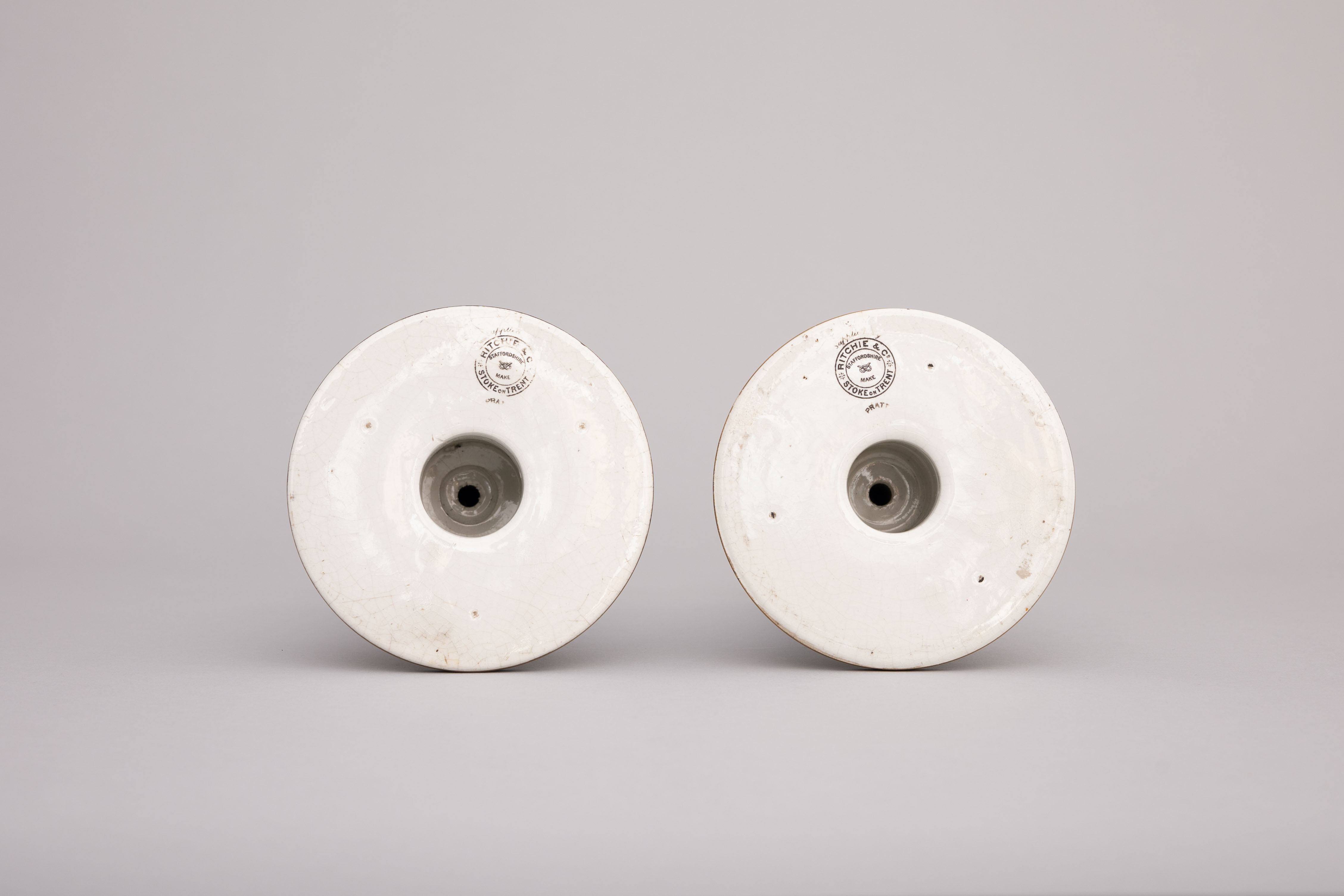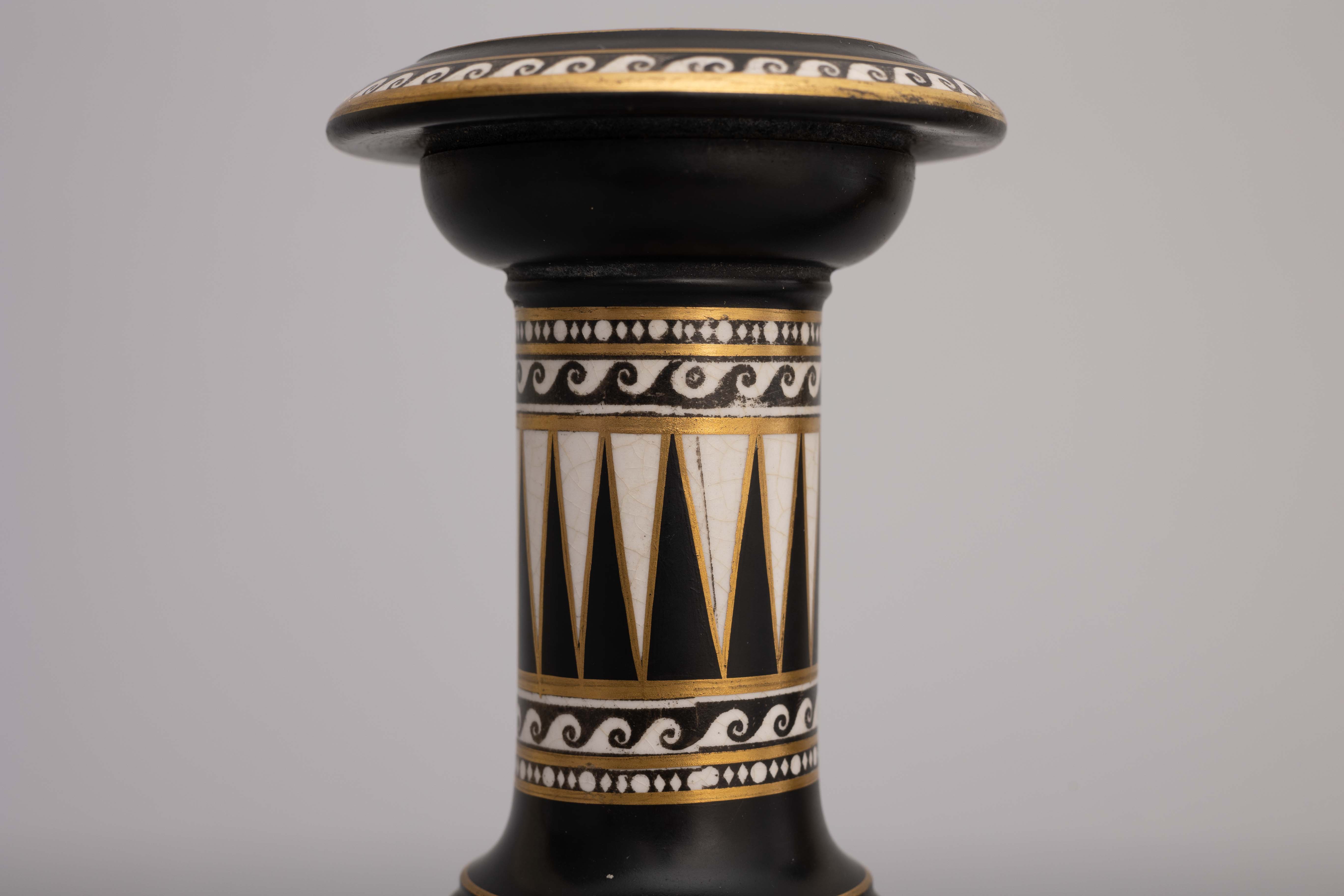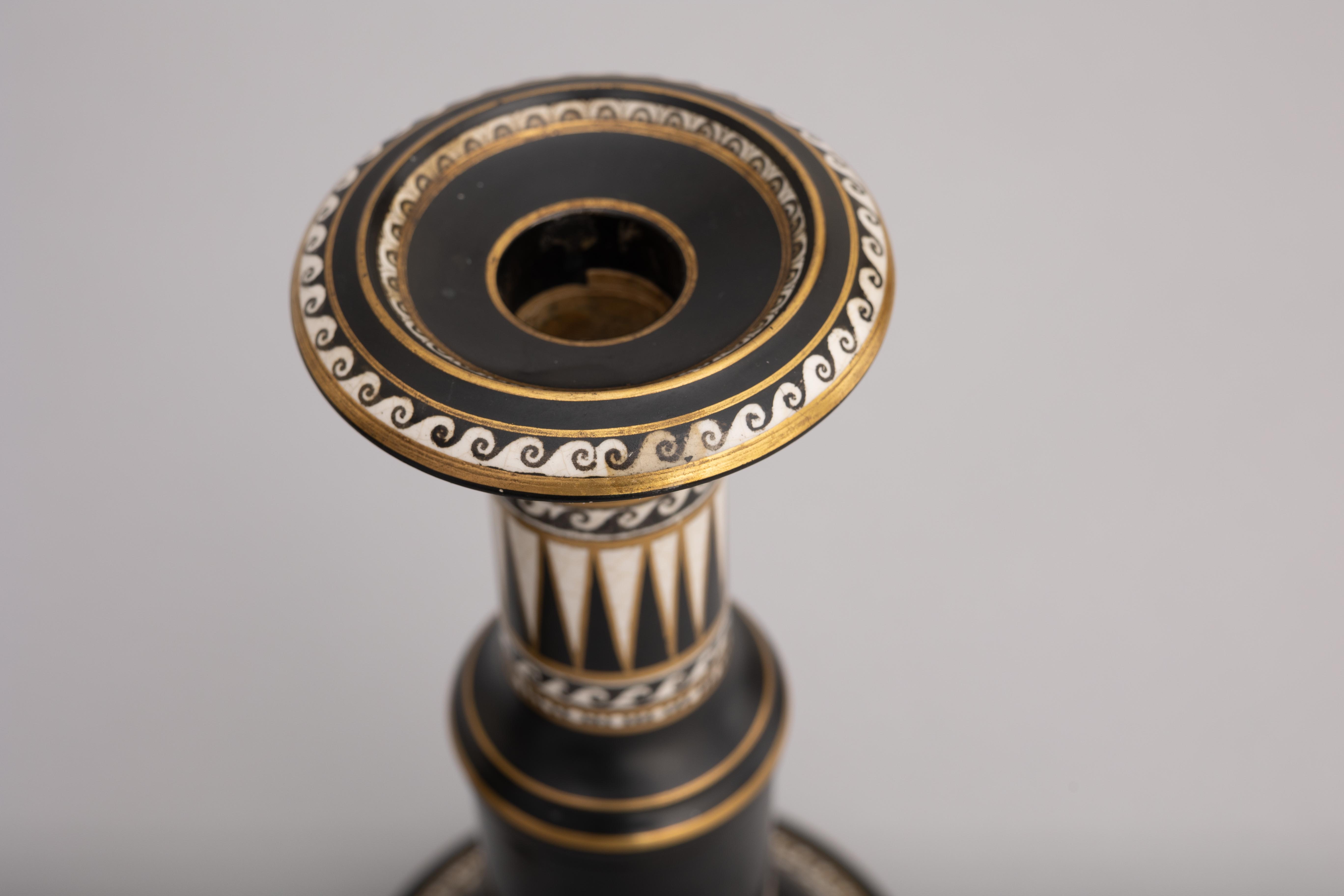Staffordshire potters Felix and Richard Pratt’s ‘Old Greek’ pattern demonstrates the lasting influence of Neoclassicism in Great Britain. The movement surfaced in the mid-eighteenth century with archaeological excavations on the Continent and lasted well into the nineteenth century. These monumental Neoclassical pottery candlesticks, made in the late nineteenth century, portray scenes from the Trojan War as a reference to an idealized Antique past.
Staffordshire potters Felix and Richard Pratt’s ‘Old Greek’ pattern demonstrates the lasting influence of Neoclassicism in Great Britain. The movement surfaced in the mid-eighteenth century with archaeological excavations on the Continent and lasted well into the nineteenth century. These monumental Neoclassical pottery candlesticks, made in the late nineteenth century, portray scenes from the Trojan War as a reference to an idealized Antique past.
Essay
Pratt & Co.’s popular ‘Old Greek’ pattern recalls the black basalt ware of Josiah Wedgwood, which itself replicated designs from Classical Greece and Rome. Indeed, British Neoclassical designers relied on copies of Antique art to create new products for modern consumers. Made in the late nineteenth century, these candlesticks represent the tradition of the copy in English Neoclassical design which existed since the movement’s inception in the eighteenth century.
The candlesticks depict The Meeting of Hector and Andromache and Andromache Fainting on the Wall, as originally created by John Flaxman in his 1793 illustrations for Homer’s Iliad. The scenes portray the events surrounding the tragic death of Hector in the Trojan War at the hands of the hero Achilles. In the first scene, the Trojan Hector prepares to fight the Greek Achilles, who has challenged him after killing Patrocles. As Hector embraces his wife, Andromache, his infant son Astyanax looks on from the arms of a nurse. In Andromache Fainting on the Wall, the result of the fight is clear: Achilles can be seen driving a chariot and dragging Hector’s lifeless body behind it.
John Flaxman was renowned as a Neoclassical designer in both his home country of Britain and abroad. He joined the Wedgwood factory in 1775 designing and sculpting decorative figures for a variety of useful and decorative wares (see this jardinière, for example), showing, as the Royal Academy states, “an early willingness to adapt his art to the requirements of commerce and decoration.” Flaxman took many of his designs from contemporary catalogs of Antique pottery, both as inspiration and direct copies. The compositions seen on these candlesticks are likely inspired by Antique designs, as some of the modern design techniques visible in the scenes, such as foreshortening, were not present in Attic pottery. Flaxman’s illustrations for the Iliad as well as other works of Classical literature gained him international recognition; the books were continually published and distributed throughout the nineteenth century.
It is interesting to view these candlesticks as an iteration in the tradition of the copy in the English Neoclassicism movement. As aforementioned, British designers often replicated Antique vase designs, which were distributed in the form of catalogs such as Sir William Hamilton’s Collection of Etruscan, Greek and Roman antiquities (see these Wedgwood dishes, for example). In fact, contemporary scholars erroneously believed that Greek vase paintings were taken from ancient wall paintings and were thus themselves a copy. Flaxman took inspiration from Neoclassical catalogs of antiquities to create the Iliad scenes as illustrations. F. & R. Pratt & Co. then reproduced Flaxman’s illustrations for their ‘Old Greek’ pattern as seen on these candlesticks.
In the twenty-first century, “copy” is often a negative term especially in relation to art. However, British Neoclassicism celebrated the copy as a tangible connection to Ancient Greece and Rome, at the time perceived to be pinnacles of civilization. Hamilton’s catalog, and others like it, situated “the ancient pot painter and his modern imitator in a genealogical tradition of copying: an aesthetic exercise that forever attempts to recoup the masterpieces of antiquity.” Copying did not dilute references to the Antique; rather, it was part of the eighteenth-century artistic rhetoric.
The copy also enabled the dissemination of Antique designs to a variety of public audiences. While upper-class patrons could afford a suite of custom-made black basalt vases inspired by Attic red-figure ware pottery, middle classes could perhaps afford a smaller home goods item like these candlesticks. Furthermore, as the Neoclassical style was deeply intertwined with the aristocratic Grand Tour, copies circulated Classical imagery to middle-class and female consumers who were typically excluded from such travels.
Neoclassical design in England often went through many forms and media, functioning not as a copy in the present-day sense but as an homage to artistic tradition. In replicating Flaxman’s illustrations the Pratt & Co. manufactory placed itself within the Neoclassical context of pride in Western cultural heritage, and translated that pride to its middle-class customers.
BT
Condition
Excellent. Superficial scratch to stem of one candlestick measuring 2 cm. Some minor areas of wax residue staining from original use.
For a detailed condition report, please contact us.
References
Coltman, Viccy. Fabricating the Antique: Neoclassicism in Britain, 1760-1800. Chicago: University of Chicago Press, 2006.
The Iliad Of Homer Engraved By Thomas Piroli From The Compositions Of John Flaxman Sculptor Rome 1793. London: Longman, Hurst, Rees & Orme, 1 March 1805. The Royal Academy, 03/2259.
Cited Works
Pratt & Co.’s popular ‘Old Greek’ pattern recalls the black basalt ware of Josiah Wedgwood, which itself replicated designs from Classical Greece and Rome. Indeed, British Neoclassical designers relied on copies of Antique art to create new products for modern consumers. Made in the late nineteenth century, these candlesticks represent the tradition of the copy in English Neoclassical design which existed since the movement’s inception in the eighteenth century.
The candlesticks depict The Meeting of Hector and Andromache and Andromache Fainting on the Wall, as originally created by John Flaxman in his 1793 illustrations for Homer’s Iliad. The scenes portray the events surrounding the tragic death of Hector in the Trojan War at the hands of the hero Achilles. In the first scene, the Trojan Hector prepares to fight the Greek Achilles, who has challenged him after killing Patrocles. As Hector embraces his wife, Andromache, his infant son Astyanax looks on from the arms of a nurse. In Andromache Fainting on the Wall, the result of the fight is clear: Achilles can be seen driving a chariot and dragging Hector’s lifeless body behind it.
John Flaxman was renowned as a Neoclassical designer in both his home country of Britain and abroad. He joined the Wedgwood factory in 1775 designing and sculpting decorative figures for a variety of useful and decorative wares (see this jardinière, for example), showing, as the Royal Academy states, “an early willingness to adapt his art to the requirements of commerce and decoration.” Flaxman took many of his designs from contemporary catalogs of Antique pottery, both as inspiration and direct copies. The compositions seen on these candlesticks are likely inspired by Antique designs, as some of the modern design techniques visible in the scenes, such as foreshortening, were not present in Attic pottery. Flaxman’s illustrations for the Iliad as well as other works of Classical literature gained him international recognition; the books were continually published and distributed throughout the nineteenth century.
It is interesting to view these candlesticks as an iteration in the tradition of the copy in the English Neoclassicism movement. As aforementioned, British designers often replicated Antique vase designs, which were distributed in the form of catalogs such as Sir William Hamilton’s Collection of Etruscan, Greek and Roman antiquities (see these Wedgwood dishes, for example). In fact, contemporary scholars erroneously believed that Greek vase paintings were taken from ancient wall paintings and were thus themselves a copy. Flaxman took inspiration from Neoclassical catalogs of antiquities to create the Iliad scenes as illustrations. F. & R. Pratt & Co. then reproduced Flaxman’s illustrations for their ‘Old Greek’ pattern as seen on these candlesticks.
In the twenty-first century, “copy” is often a negative term especially in relation to art. However, British Neoclassicism celebrated the copy as a tangible connection to Ancient Greece and Rome, at the time perceived to be pinnacles of civilization. Hamilton’s catalog, and others like it, situated “the ancient pot painter and his modern imitator in a genealogical tradition of copying: an aesthetic exercise that forever attempts to recoup the masterpieces of antiquity.” Copying did not dilute references to the Antique; rather, it was part of the eighteenth-century artistic rhetoric.
The copy also enabled the dissemination of Antique designs to a variety of public audiences. While upper-class patrons could afford a suite of custom-made black basalt vases inspired by Attic red-figure ware pottery, middle classes could perhaps afford a smaller home goods item like these candlesticks. Furthermore, as the Neoclassical style was deeply intertwined with the aristocratic Grand Tour, copies circulated Classical imagery to middle-class and female consumers who were typically excluded from such travels.
Neoclassical design in England often went through many forms and media, functioning not as a copy in the present-day sense but as an homage to artistic tradition. In replicating Flaxman’s illustrations the Pratt & Co. manufactory placed itself within the Neoclassical context of pride in Western cultural heritage, and translated that pride to its middle-class customers.
BT
Excellent. Superficial scratch to stem of one candlestick measuring 2 cm. Some minor areas of wax residue staining from original use.
For a detailed condition report, please contact us.
Coltman, Viccy. Fabricating the Antique: Neoclassicism in Britain, 1760-1800. Chicago: University of Chicago Press, 2006.
The Iliad Of Homer Engraved By Thomas Piroli From The Compositions Of John Flaxman Sculptor Rome 1793. London: Longman, Hurst, Rees & Orme, 1 March 1805. The Royal Academy, 03/2259.
This item ships free to the continental US, and globally for a flat-rate fee of $75.
All objects are packed with utmost care by our team of expert fine art shippers. All items are shipped with parcel insurance.
For more information on our shipping policies, please visit our FAQ Page.

